Wages in the Nonprofit Sector: Healthcare, Personal Care, and Social Service Occupations
Originally Posted: January 27, 2009 The National Compensation Survey now publishes wage data on full-time workers in private nonprofit establishments. This is the third in a series of three articles comparing the average hourly earnings of full-time workers in private nonprofits, private industry as a whole, State governments, and local governments. In 2007, there were more than 1.64 million nonprofit organizations in the United States.1 Nonprofits include, but are not limited to, hospitals, churches, educational institutions, social welfare organizations, and charitable organizations. Health professionals, educators, other professionals, health technicians, administrative support workers, and service occupations account for the majority of paid workers in the nonprofit sector.2 The National Compensation Survey (NCS) provides a source of recent data to compare the wage rates of workers in nonprofits with those of their counterparts in private industry as a whole3 and in State and local government. Separate wage estimates for full-time workers in private nonprofit establishments in 2007 were published in National Compensation Survey: Occupational Earnings in the United States, 2007.4 The NCS now provides average hourly wage estimates by occupational group and by detailed occupation for full-time workers employed in all private industry, in the private nonprofit sector, in State government, and in local government.5 Organizations that provide health services account for 37 percent of the revenues of the entire nonprofit sector.6 Healthcare establishments include hospitals, nursing homes, doctor’s offices, and home health agencies. More than half of all hospitals7 and about 31 percent of nursing homes are nonprofit.8 Physicians, nurses, laboratory technicians, and medical assistants are some of the occupations found in healthcare establishments. Some workers, such as home care aides, work in health-related fields, but their jobs are not classified in the healthcare occupation groups; their jobs are in the personal care and service occupations group. The personal care and services group also includes many other occupations, ranging from child care workers to residential advisors of colleges and boarding schools. Social services--such as child welfare agencies, community food and housing organizations, job training, and social welfare programs--assist individuals and families. Nonprofit organizations sometimes supplement programs provided by government agencies and for-profit businesses. Nonprofits are often contracted to administer programs that are created, overseen, and funded by State or Federal government (or both).9 There are several hypotheses used to explain why the wages of nonprofit workers differ from those of their for-profit counterparts. According to the labor donation hypothesis, workers in the nonprofit sector are willing to donate a portion of their paid labor and receive lower wages because they obtain satisfaction from the fact that their efforts achieve altruistic goals. Also, nonprofits might pay lower wages and compensate their workers with employer-provided benefits or other favorable job characteristics such as a flexible work schedule. On the other hand, some nonprofits might actually pay higher wages because nonprofits do not benefit from the cost reductions of paying lower wages in the same way that for-profit employers do. In addition, nonprofits may choose to hire better quality workers in order to produce a better quality product or service and pay these employees higher wages.10 Using data from the 2007 National Compensation Survey, this third and final article of the series compares the wages of full-time private nonprofit workers in healthcare, personal care, and social service occupations with the wages of workers in the same occupations in all private industry, in State government, and in local government. The comparisons are made for occupational groups and for specific occupations.11 The first article in the series examines the wages of workers in management, selected professional, and administrative support occupations; the second article examines the wages of occupations typically found in educational and research institutions. Healthcare practitioner and technical occupationsDentists, pharmacists, therapists, and registered nurses are a few of the occupations in the healthcare practitioner and technical occupational group. As chart 1 below shows, wages for healthcare practitioner and technical occupations at nonprofit establishments ($28.85) were higher in 2007 than they were for the same occupations in State government ($23.89) and in local government ($27.30).12 In private industry as a whole, these occupations received hourly rates ($30.11) that were not significantly greater than those in the nonprofit sector. 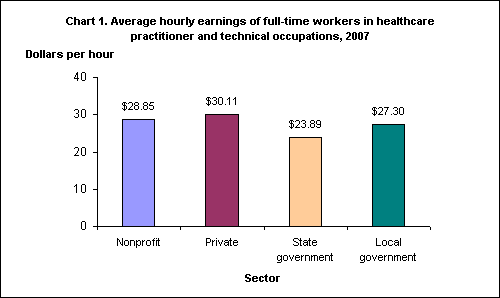 Physicians and surgeons. Physicians and surgeons is a broad occupation group that is further separated into specific occupations such as general practitioners, psychiatrists, pediatricians, and so on. Chart 2 shows that physicians and surgeons earned more per hour in nonprofit establishments ($54.62) in 2007 than they did at State and local government establishments ($40.41).13 However, physicians and surgeons employed by private establishments earned considerably more per hour ($86.63) than those employed by nonprofits. 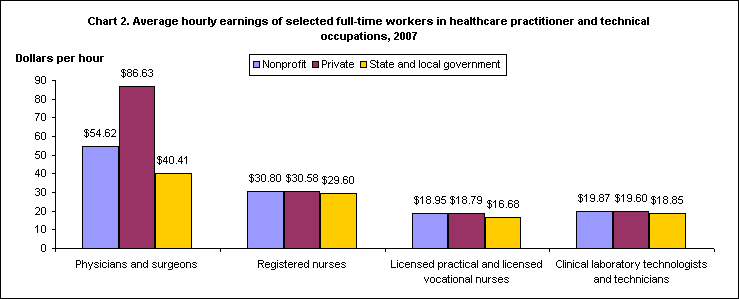 Registered nurses. Registered nurse is the largest healthcare occupation in terms of employment, with 2.5 million workers.14 Hourly wages for registered nurses were similar at nonprofits ($30.80), all private establishments ($30.58), and State and local governments ($29.60).15 Licensed practical and licensed vocational nurses. Licensed practical and licensed vocational nurses are supervised by physicians and registered nurses.16 They provide basic care to patients and assist other healthcare providers. Chart 2 shows that the average hourly earnings of licensed practical and licensed vocational nurses were lower at State and local governments ($16.68 per hour) than they were at nonprofits ($18.95 per hour). Wages at nonprofits for this occupation were similar to those at all private establishments ($18.79 per hour). Clinical laboratory technologists and technicians. Clinical laboratory technologists and technicians perform medical laboratory tests used to diagnose various diseases and other ailments. These workers are employed by hospitals, clinics, or establishments that provide medical testing services. As can be seen in chart 2, the hourly wages of clinical laboratory technologists and technicians were similar at nonprofits ($19.87), in private industry as a whole ($19.60), and in State and local governments ($18.85).17 Healthcare support occupationsHealthcare support occupations include such occupations as nursing aides, orderlies, and medical assistants. As chart 3 shows, healthcare support occupations at nonprofits averaged $12.12 per hour, similar to the wages of these occupations employed by local government ($12.30 per hour). In State government, however, these occupations earned more per hour ($13.42) than in nonprofits. In private establishments, these occupations earned an average of $12.51 per hour, which is similar to the wages at nonprofits. Nursing aides, orderlies, and attendants at nonprofits averaged $11.99 per hour and earned more than those in all private establishments ($11.32 per hour), but not significantly more than workers in State and local governments ($11.44 per hour).18 Medical assistants earned similar hourly wages at nonprofits ($14.03), in State and local government ($14.05),19 and at private establishments ($13.42). 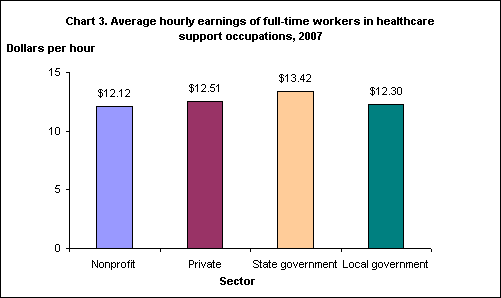 Personal care and service occupationsPersonal care and service occupations include such occupations as child care workers and home care aides. Home care aides work in patients’ homes or in residential care facilities. As chart 4 shows, workers in these occupations earned less at nonprofits ($10.86 per hour) than at local governments ($13.91 per hour). The average hourly wages of nonprofit personal care and service workers did not differ significantly from those of private industry workers ($11.15) and those of State government workers ($13.18 per hour). Child care workers had higher hourly wages at State and local government ($13.13)20 than at nonprofits ($10.08) and private industry ($9.00). The hourly earnings of personal and home care aides at nonprofits ($10.52), at private establishments ($10.20), and in State and local government ($11.52) were similar to one another--that is, the differences were not statistically significant. 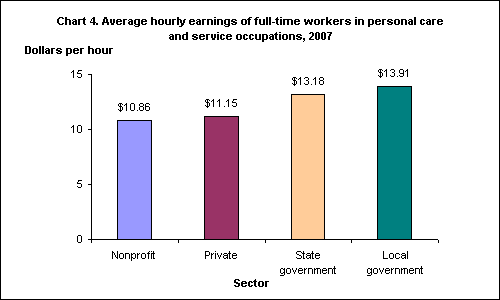 Community and social services occupationsCommunity and social service workers include social workers, counselors, and religious workers. These workers can be found at State and local welfare agencies, community service organizations, hospitals, and schools. As can be seen in chart 5, community and social service occupations at nonprofits earned considerably less per hour ($17.68) than did their counterparts in local government establishments, where the average was $27.51 per hour. Community and social service workers in nonprofits earned less than those in State governments ($20.80 per hour), but had very similar earnings compared to those in private industry ($17.82 per hour). Social workers, a group that includes specific occupations such as family, public health, and mental health social workers, earned $19.49 per hour at nonprofits, less than their counterparts at local governments ($25.96 per hour). Counselors--including substance abuse, behavioral disorder, and mental health counselors--earned considerably more per hour in local government ($33.39) than they did at nonprofits ($17.91). Wages for counselors in State government ($23.36 per hour) also were higher than at nonprofits. 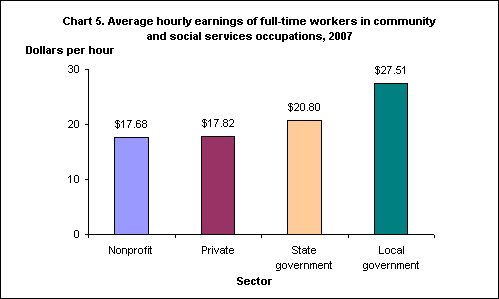 SummaryUsing data from the 2007 National Compensation Survey to compare the wages of full-time workers in nonprofit organizations with those of their counterparts in all private industry, in State government, and in local government, the following results were found:
NOTE: Data for private industry in this article have been revised. When the article was originally published, the tabulations for private industry incorrectly included State and local government workers, in addition to private sector workers. The error has been corrected.
Notes1 Data on the total number of tax-exempt organizations are from Internal Revenue Service Data Book 2007, Publication 55B (Internal Revenue Service, March 2008), table 25; available on the Internet at http://www.irs.gov/taxstats/article/0,,id=168593,00.html. Churches are not required to apply for recognition of tax exemption. 2 Christopher J. Ruhm and Carey Borkoski, “Compensation in the Nonprofit Sector,” The Journal of Human Resources, autumn 2003, pp. 992–1021. 3 Private industry includes both nonprofit and for-profit establishments. Wage estimates for employees of for-profit establishments were not available. 4 National Compensation Survey: Occupational Earnings in the United States, 2007, Bulletin 2704 (Bureau of Labor Statistics, August 2008); available on the Internet at http://www.bls.gov/ncs/ncswage2007.htm. The National Compensation Survey (NCS) has always included nonprofit establishments in its private industry measures of occupational earnings, compensation cost trends, benefit incidence, and detailed benefits provisions. For more information on the National Compensation Survey, see BLS Handbook of Methods, Chapter 8, “National Compensation Measures,” available on the Internet at http://www.bls.gov/opub/hom/homtoc.htm. 5 Occupations are classified according to the 2000 Standard Occupational Classification (SOC) system, which categorizes more than 800 individual occupations into 23 major groups. The National Compensation Survey does not survey agriculture, Federal government, military, or private household employers. For more information on the detailed occupations included in each major occupational group, see National Compensation Survey: Occupational Earnings in the United States, 2006, “Appendix B. Standard Occupational Classification System,” available on the Internet at http://www.bls.gov/ncs/ocs/sp/ncbl0841.pdf. 6 Registered Nonprofit Organizations by Major Purpose or Activity, Internal Revenue Service, Exempt Organizations Business Master File, January 2008; available from the Urban Institute, National Center for Charitable Statistics, on the Internet at http://nccsdataweb.urban.org/NCCS/Public/index.php. 7 According to data from the U.S. Census Bureau, there were 5,756 hospitals in the United States in 2005, and 2,958 of them were nongovernmental and nonprofit. See Statistical Abstract of the United States: 2008 (U.S. Census Bureau), table 163; available on the Internet at http://www.census.gov/compendia/statab/index.html. 8 According to data from the National Center for Health Statistics, there were 16,100 nursing homes in 2004, and 5,000 of them were voluntary nonprofit establishments. See National Center for Health Statistics, National Nursing Home Survey (NNHS), 2004 Facility Tables, table 1; available on the Internet at http://www.cdc.gov/nchs/about/major/nnhsd/Facilitytables.htm. 9 Steven Rathgeb Smith, “Social Services,” ch. 4 in Lester M. Salamon, ed., The State of Nonprofit America. (Washington, DC, Brookings Institution Press, 2002). 10 See Christopher J. Ruhm and Carey Borkoski, “Compensation in the Nonprofit Sector,” The Journal of Human Resources, autumn 2003, pp. 992–1021; also, Laura Leete, “Whither the Nonprofit Wage Differential? Estimates from the 1990 Census,” Journal of Labor Economics, January 2001, pp. 136–70. 11 That is, those workers who are classified in the same occupations according to the 2000 Standard Occupational Classification (SOC) system. 12 Statements of comparisons in this article are significant at a standard error level of 1.645 or more (90-percent confidence level), unless indicated otherwise. See table 1 for wage estimates and the corresponding relative standard errors. 13 Combined wage estimate for State and local government workers. 14 See “Registered Nurses” in Occupational Outlook Handbook, 2008-09 Edition (Bureau of Labor Statistics), available on the Internet at http://www.bls.gov/oco/ocos083.htm. 15 Combined wage estimate for State and local government workers. 16 Licensed practical nurses and licensed vocational nurses care for people who are sick, injured, convalescent, or disabled under the direction of physicians and registered nurses. For more information, see Occupational Outlook Handbook, 2008-09 Edition, “Licensed Practical and Licensed Vocational Nurses,” on the Internet at http://www.bls.gov/oco/ocos102.htm. 17 Combined wage estimate for State and local government workers. 18 Combined wage estimate for State and local government workers. 19 Combined wage estimate for State and local government workers. 20 Combined wage estimate for State and local government workers.
|
Tools |
Calculators |
Help |
Info |